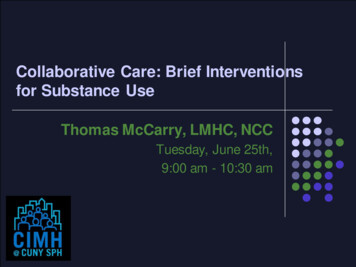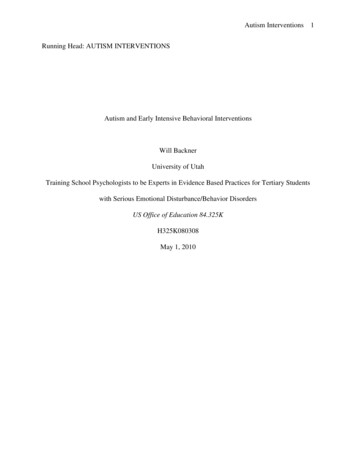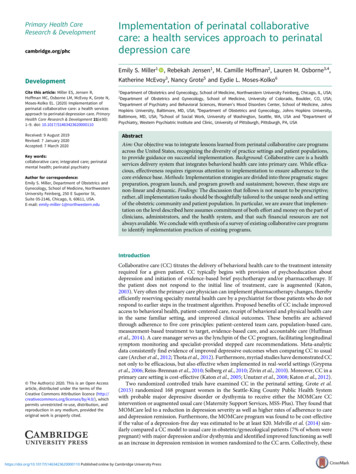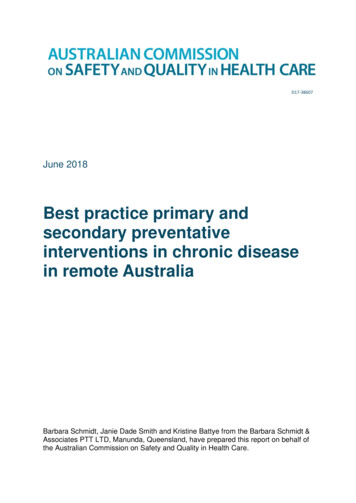
Transcription
Collaborative Care: Brief Interventionsfor Substance UseThomas McCarry, LMHC, NCCTuesday, June 25th,9:00 am - 10:30 am
Agenda How does this fit into Collaborative Care? Evidence-based screening tools. Brief Interventions.
The problem 27 million people use of illicit drugs or misuse ofprescription drugs 66 million reported binge drinking "in the pastmonth."“Most Americans know someone who has been touched by an alcoholor a drug use disorder. Yet, 90 percent of people with a substance usedisorder are not getting treatment. That has to change.”Facing Addiction in America: The Surgeon General's Report on Alcohol, Drugs and Health 2016
Consequences In 2015, 26.9 percent of people ages 18 or olderreported that they engaged in binge drinking in the pastmonth;7.0 percent reported that they engaged in heavy alcoholuse in the past month. 2015 National Survey on Drug Use and Health (NSDUH). An estimated 88,000 people (approximately 62,000 menand 26,000 women) die from alcohol-related causesannually Mokdad, A.H 2000 In 2014, alcohol-impaired driving fatalities accounted for9,967 deaths (31 percent of overall driving fatalities)
THE OPPORTUNITY 462 million primary care visits in 2008Estimated increase to 565 million by 2025. (Petterson et al, 2012) Substance use often linked to presenting symptoms(e.g., injuries, hypertension) Stigma can be minimized in PHC setting Early intervention and secondary prevention You are respected and trusted
Models for Treatment ofSubstance Use No Treatment (90%) Serial Treatment Concurrent/Parallel Treatment Integrated Treatment
What We Sometimes Hear “I refer all of my patients out to Substance useTreatment” “I don’t have the knowledge to assess or intervene” “With such a short amount of time I don’t have time toask or address substance use” “We have so many other initiatives”
Collaborative Care Benefits Integrated treatment is associated with the followingpositive outcomes (Drake, et al., 2001) Reduced substance use Improvement in psychiatric symptoms and functioning Decreased hospitalization Increased housing stability Fewer arrests Improved quality of life
SCREENING FORSUBSTANCE USE
Goals of Screeningand Brief Interventions Assist healthcare providers to screen and provideadvice or counseling to their patients who misusealcohol or other drugs To influence risky behavior patterns and reduceexposure to the negative consequences ofmisuse To improve linkages between general communityhealth care and specialized substance abuseproviders to facilitate access to care whenneeded
Screening vs. AssessmentScreening Brief process foridentifying if a disorder ispresentGoal is to determinewhether patient should bereferred for furtherassessmentAssessment More detailed process oflooking at severalfunctional domains inorder to establishdiagnosesGoal is to determineaccurate diagnosis,establish problem listsand set treatment goals
Screening Identifies individuals with problemsrelated to alcohol or substance use Beneficial to use a consistent tool thathas been found to be reliable and valid Can be done through interview or selfreport
Screening: The AUDIT
Screening: The AUDIT
Who aretargets forSBI?Note: represents thegeneral adult population inthe US. The % of high-riskdrinkers is likely to be muchhigher in certain settingssuch as emergency ortrauma departments.
What is Risky Drinking? Women: 2 drinks per occasion; 7/week Over 65: 2 drink per occasion; 7/week Men: 4 drinks per occasion; 14/week Any use is risky when: Pregnant Driving Taking certain medications Having certain medical conditions In recovery from addiction/cannot control drinking Hazardous: Pattern that increases risk for adverseconsequences Harmful: Negative consequences have already occurred
Drug Abuse Screening TestDAST - 10
Drug Abuse Screening TestDAST - 10
SCREENING FORSUBSTANCE USE
Brief Interventions Evidence-based practices Motivate individuals at risk of substanceabuse to change their behavior Or to encourage those with more seriousdependence to accept more intensivetreatment
Brief Interventions: FRAMES Feedback: Give feedback on the risks and negativeconsequences of substance use.Responsibility: Emphasize individual’s role in making decisionsAdvice: Give straightforward advice on modifying drug use.Menu of options: Involve client in decision-making.Empathy: Be empathic, respectful, and non-judgmental.Self-efficacy: Express optimism of ability to changeHester RK, Miller WR. Handbook of Alcoholism Treatment Approaches. 2 ed. Boston, MA: 1995.
Brief Interventions: FLO Feedback Listen OptionsSubstance Abuse and Mental Health Services Administration, 2007.
Brief Interventions: FLO Feedback (1-2 minutes)AUDIT and DAST have been given to thousands ofpatients in medical settings, so you can compare yourdrinking to others.Normal AUDIT-C scores are 0-4 for men and 0-3 forwomen, which is low-risk drinking; Normal DASTscore is 0.Give result: Your score was which places you in thecategory for higher risk of harm.Elicit reaction: What do you make of that?
Brief Interventions: FLO Listen & Elicit (1-5 Min)Explore pros and cons of drinking or drug use.Summarize both sides.Ask about importance. “On a scale of 1-10, howimportant is it to you to ”Ask about confidence.- Why did you give it a 6 and not a 4?- What would it take to raise that to a 7?
Brief Interventions: FLO Options & Goal Setting (1-5 min) Ask about what they want to change, what is their goal.So, Where does this leave you now? What is yourgoal around .If appropriate, ask about the plan.What will you need to do first?Who could help you, what would that look like?What might get in the way?
Brief Interventions: FLO Options & Goal Setting (1-5 min) Ask about what they want to change, what is their goal.So, Where does this leave you now?Ask about the plan. What will you need to do first?Who could help you, what would that look like?What might get in the way? Offer a Menu of options if needed.Agree on a follow up plan.
Stages of Change
Stages of Change Provides an Understanding andappreciation of Behavior ChangeCyclical in natureApplicable in Lifestyle Behavior Changes Disease preventionDisease managementAnticipates relapseRecognizes barriers to change
Pre-contemplative Establish rapport, ask permission, and build trust.Raise doubts or concerns in the client about substanceusing patterns by: Exploring the meaning of events that brought the client totreatment or the results of previous treatments Eliciting the client’s perceptions of the problemOffering factual information about the risks of substance use Examining discrepancies between the client’s and others’perceptions of the problem behaviorExpress concern and keep the door open .
Decisional Balance
MEDICATIONASSISTEDTREATMENT (MAT)
Availability of PharmacologicTreatments by Substance ClassFDA-approvedMedications Available High physiologicdependence AlcoholSedativesOpiatesNicotineNo FDA-approvedMedications Available Little to no physiologicdependence MarijuanaCocaine/StimulantsHallucinogens
Medication Assisted TreatmentOpioid Methadone (Full Agonist) Naltrexone / Vivitrol (Antagonist) Provided daily at a clinic, gradually less frequentProvided orally or by injectionBuprenorphine / Suboxone (Partial Antagonist) Provided orally or by injection
Advantages ofBuprenorphine Treatment Increased access totreatment because ofoffice/physician-basedprescribingDispensed at pharmacyfor up to one month decreased frequency ofvisitsOnce daily dosing Greater safety inoverdose Lower level of physicaldependence Relatively low potentialfor abuse
NYS Opioid OverdosePrevention Programs Eligible, registered entities provide training to individuals in thecommunity on how to respond to an overdose
REFERRAL TOTREATMENT
When to Refer Some patients need a higher level of care fortreatment of substance use disorders Active, unstable substance use of moderate tohigh severityAs recommended by psychiatric consultantIf requested by patient
Summary Substance abuse has significantconsequences on physical and behavioralhealth, public health and health care costsScreening and brief intervention forsubstance use should be a routine part ofphysical health servicesAnd is absolutely within the scope andtraining of collaborative care.
QuestionsThank you and good luck!Thomas McCarry LMHCMcCarryt@gmail.com
Resources AUDIT & DAST: http://www.sbirt.care/tools.aspxSAMHSA TIP 34: Brief Interventions for Substance df/Bookshelf NBK64947.pdfSAMHSA TIP 35: Enhancing Motivation in Substance BK64967/pdf/Bookshelf NBK64967.pdfFRAMES index.cfm?stid 242FLO nn%20and%20Field.pdf
Raise doubts or concerns in the client about substance-using patterns by: Exploring the meaning of events that brought the client to treatment or the results of previous treatments Eliciting the client's perceptions of the problem Offering factual informationabout the risks of substance use











